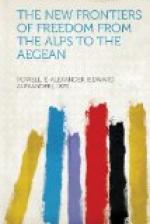The palace known as the Old Konak, where King Alexander and Queen Draga were assassinated under peculiarly revolting circumstances on the night of June 11, 1905, and from an upper window of which their mutilated bodies were thrown into the garden, has been torn down, presumably because of its unpleasant associations for the present dynasty, but only a stone’s throw away from the tragic spot is being erected a large and ornate palace of gray stone, ornamented with numerous carvings, as a residence for Prince-Regent Alexander, who, when I was there, was occupying a modest one-story building on the opposite side of the street. By far the most interesting building in Belgrade, however, is a low, tile-roofed, white-walled wine-shop at the corner of Knes Mihajelowa Uliza and Kolartsch Uliza, which is pointed out to visitors as “the Cradle of the War,” for in the low-ceilinged room on the second floor is said to have been hatched the plot which resulted in the assassination of the Austrian archducal couple at Serajevo in the spring of 1914 and thereby precipitated Armageddon.
[Illustration: THE WINE-SHOP WHICH IS POINTED OUT TO VISITORS AS “THE CRADLE OF THE WAR”]
In this connection, here is a story, told me by a Czechoslovak who had served as an officer in the Serbian army during the war, which throws an interesting sidelight on the tragedy of Serajevo. This officer’s uncle, a colonel in the Austrian army, had been, it seemed, equerry to the Archduke Ferdinand, being in attendance on the Archduke at the Imperial shooting-lodge in Bohemia when, early in the spring of 1914, the German Emperor, accompanied by Admiral von Tirpitz, went there, ostensibly for the shooting. The day after their arrival, according to my informant’s story, the Emperor and the Archduke went out with the guns, leaving Admiral von Tirpitz at the lodge with the Archduchess. The equerry, who was on duty in an anteroom, through a partly opened door overheard the Admiral urging the Archduchess to obtain the consent of her husband—with whom she was known to exert extraordinary influence—to a union of Austria-Hungary with Germany upon the death of Francis Joseph, who was then believed to be dying—a scheme which had long been cherished by the Kaiser and the Pan-Germans.
“Never will I lend my influence to such a plan!” the equerry heard the Archduchess violently exclaim. “Never! Never! Never!”




